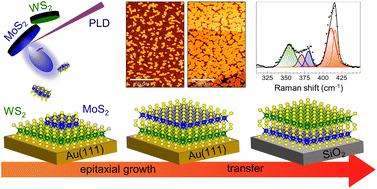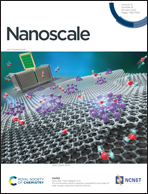Interface coupling in Au-supported MoS2–WS2 heterobilayers grown by pulsed laser deposition†
Abstract
Van der Waals heterostructures of transition metal dichalcogenides (TMDs) are promising systems for engineering functional layered 2D materials with tailored properties. In this work, we study the growth of WS2/MoS2 and MoS2/WS2 heterobilayers by pulsed laser deposition (PLD) under ultra-high vacuum conditions. Using Au(111) as growth substrate, we investigated the heterobilayer morphology and structure at the nanoscale by in situ scanning tunneling microscopy. Our experiments show that the heterostructure growth can be controlled with high coverage and thickness sensitivity by tuning the number of laser pulses in the PLD process. Raman spectroscopy complemented our investigation, revealing the effect of the interaction with the metallic substrate on the TMD vibrational properties and a strong interlayer coupling between the MoS2 and WS2 layers. The transfer of the heterobilayers on a silica substrate via a wet etching process shows the possibility to decouple them from the native metallic substrate and confirms that the interlayer coupling is not substrate-dependent. This work highlights the potential of the PLD technique as a method to grow TMD heterostructures, opening to new perspectives in the synthesis of complex 2D layered materials.



 Please wait while we load your content...
Please wait while we load your content...